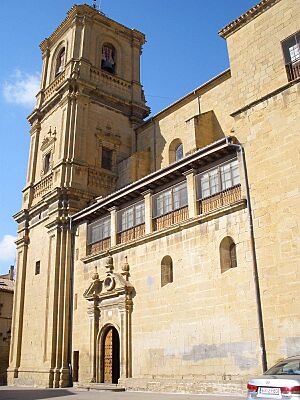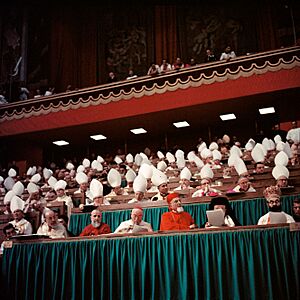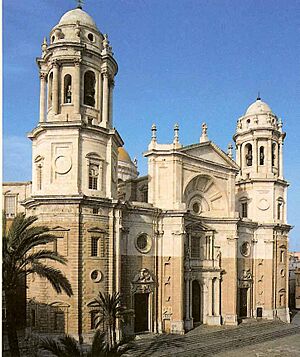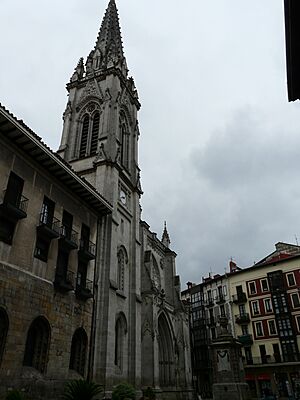Antonio Añoveros Ataún facts for kids
Quick facts for kids
Antonio Añoveros Ataún
|
|
|---|---|
| Born |
Antonio Añoveros Ataún
1909 |
| Died | 1987 (aged 77–78) |
| Nationality | Spanish |
| Occupation | Bishop |
Antonio Añoveros Ataún (1909–1987) was an important Roman Catholic priest and bishop from Spain. He is best known for something called the "Añoveros case" in 1974. This event caused a very serious disagreement between the Spanish government at the time (led by Francisco Franco) and the Church.
Even though he joined a group called the Carlists during the Spanish Civil War, he became known as one of the more open-minded Church leaders in Spain later on. Many people, especially in the Basque Country, remember him fondly.
Contents
Early Life and Becoming a Priest
Antonio Añoveros Ataún was born in Pamplona, Spain, in 1909. His father, Julio Añoveros Monasterio, worked for the tobacco company and the city council. His mother, Claudia Ataún Sanz, was very religious.
Antonio first went to school at a college run by the Marist Brothers in Pamplona. He then studied law at the Universidad de Zaragoza. However, he soon decided to become a priest. He returned to Pamplona and joined the seminary. In 1933, he became a priest and started working at the St. Nicholas parish in Pamplona. He also taught at the Pamplona seminary.
The Spanish Civil War
When the Spanish Civil War started in 1936, Antonio's older brother joined the Carlist militia, a traditionalist group. Antonio also joined as a chaplain, which is a priest who serves with the military. He helped soldiers in hospitals and even administered sacraments to soldiers from both sides of the conflict.
He was present during a very sad event where many prisoners were executed. He later said it was the worst day of his life and that he was terrified. After the war, he continued his work, even helping to distribute a Carlist newspaper in Madrid.
Becoming a Bishop
After the Civil War, Antonio Añoveros worked in different roles within the Church. He became a parish priest in Tafalla, a town in Navarre, where he was known as a clever and determined priest who cared for the poor. He stayed there until 1950.
In 1950, he moved to Málaga in southern Spain. He became a high-ranking priest at the cathedral and helped lead the local seminary. He worked closely with Bishop Angel Herrera Oria, a very influential figure. In 1952, Antonio Añoveros became an Auxiliary Bishop in Málaga.
Later in 1954, he moved to Cádiz and Ceuta to become the Coadjutor Bishop. This meant he would take over as the main bishop when the current one retired or passed away.
Caring for the Poor
Even though he came from a comfortable family, Antonio Añoveros was always interested in helping people in need. He worked with Catholic groups that focused on social issues and charity. He often visited poor areas of the cities he served.
At first, his focus on social issues seemed to fit with the government's ideas. He even met Francisco Franco, Spain's leader, and a photo of them chatting was published. However, as time went on, his views on social justice started to differ from the official government policy.
The Second Vatican Council
Antonio Añoveros took part in all four sessions of the Second Vatican Council (Vaticanum II) from 1962 to 1965. This was a huge meeting of Catholic bishops from all over the world that aimed to modernize the Church.
During the Council, he was seen as a moderate, not fully on the side of the reformers or the conservatives. He spoke about several important topics:
- He supported using local languages (not just Latin) in church services, which made it easier for people to understand.
- He also supported giving more importance to priests and bishops working together.
- He was very interested in improving relations with non-Christian religions, especially Muslims. He believed Christians should respect Muslim spiritual values and that dialogue between the faiths was important.
Religious Freedom Debates
Añoveros also contributed to discussions about religious freedom. He believed that while people should have religious freedom, the government could set some limits to protect public peace, morality, and the rights of citizens. He wanted the Council's document on religious freedom to be very clear about these limits.
Bishop of Cádiz and Ceuta
In 1964, after the previous bishop passed away, Antonio Añoveros became the main bishop of Cádiz and Ceuta. Even with his duties at the Vatican Council, he was known for leading his diocese strongly, focusing on the seminary (where priests are trained) and social issues.
His support for Catholic worker groups, like HOAC and JOC, became more noticeable. These groups were starting to challenge the government's policies. Añoveros often spoke about the struggles of poor workers and criticized the lack of care from wealthier people. He was careful not to openly confront the government at first.
However, as the 1960s ended, his sermons and letters became more critical. He talked about "the oppressed" and pushed for a Church that was more in line with the spirit of Vatican II. His words were widely reported in the Spanish press, and he became a well-known figure. In 1970, a Catalan magazine even named him "Person of the Year."
He also supported the idea of "worker-priests," encouraging young priests-in-training to work in local factories to understand the lives of ordinary people. Because of his focus on social issues and his down-to-earth approach, some people compared him to Hélder Câmara, a famous bishop from Latin America known for his "liberation theology." By the early 1970s, Spanish officials saw him as a challenging figure.
Bilbao: The "Añoveros Case"
In December 1971, Antonio Añoveros was appointed the bishop of Bilbao. This was a difficult region, and some people believe the Vatican chose him to avoid government influence, while others think Franco's government hoped his popularity would help calm the area.
Añoveros quickly showed his support for Basque nationalism, a movement seeking more rights for the Basque region. He avoided official government events and defended Basque priests who were being persecuted.
The Crisis of 1974
The conflict with the Francoist government reached its peak in February 1974. Añoveros issued a pastoral letter (a letter from a bishop to his diocese) called Christianity, a Message of Salvation for Peoples. In this letter, he subtly called for more cultural freedom for the Basque people and a change in government policy regarding regional rights.
This letter came just two months after ETA terrorists had assassinated a high-ranking government official. The government, led by Carlos Arias Navarro, reacted strongly. They put Añoveros under house arrest and even sent a plane to take him out of the country. In response, some other bishops threatened to excommunicate (remove from the Church) government officials.
Eventually, Franco himself stepped in and calmed the situation. Añoveros was allowed to go on a long vacation instead of being exiled. This event, known as the "Añoveros case," was the most serious crisis between Franco's government and the Church.
Later Years
Añoveros returned to Bilbao during the final months of Franco's rule, but his health was declining. He suffered from heart problems and spent long periods getting treatment. During Spain's transition to democracy, he mostly avoided political issues, focusing instead on the Church's spiritual role.
In 1977, he received a special honor from the Pope. In 1978, he resigned as bishop due to his poor health and became bishop emeritus. He chose to stay in Bilbao, the city he had served, even though he was offered a residence in his hometown of Pamplona. He passed away in 1987 after a stroke and lung disease.
See Also
 In Spanish: Antonio Añoveros Ataún para niños
In Spanish: Antonio Añoveros Ataún para niños
- Carlism
- Francoist Spain
- Basque nationalism
- Spanish Transition
- Vaticanum II







